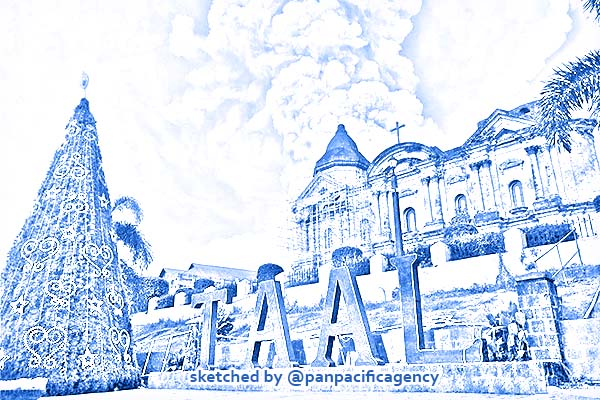Philippines’ Taal’s main crater lake has been drained

This handout photo taken and received on January 12, 2020 courtesy of Renz Lejarso Guevara shows ash from the Taal volcano (not pictured) in the air, as seen against a church in the foreground in the town of Taal in Batangas province south of Manila. A volcano near the Philippine capital Manila spewed a massive cloud of ash into the sky on January 12, forcing the precautionary evacuation of thousands of residents, authorities said. AFP/Courtesy of Renz Lejarso Guevara/Handout. Sketched by the Pan Pacific Agency.
MANILA, Jan 16, 2020, PhilStar. The water in the main crater lake of Taal Volcano has drained away, three days after the volcano exploded to life, state volcanologists said. In a bulletin issued Wednesday afternoon, the Philippine Institute of Volcanology and Seismology said satellite images show that the volcano’s main crater lake—once blue-green in color—has been drained, The Philippine Star reported.
Taal’s main crater lake is 1.9 kilometers in diameter and four meters above sea level.
Ma. Antonia Bornas, chief of Phivolcs volcano monitoring division, explained the draining of the main crater lake is related to ground deformation, which is caused by the upward movement of magma. Magma is molten rock beneath Earth’s surface.
Phivolcs also observed that portions of Pansipit River—drainage outlet of Taal Lake—have also dried up.
“‘Yung pinaka-evident [na explanation] ay dahil sa sunud-sunod na paglindol umatras ‘yung tubig ng lawa at natuyo ‘yung portions ng Pansipit River. Nagkaroon siguro ng pag-alsa or uplift nung Taal region,” Bornas said.
(The most evident explanation is that the consecutive earthquakes caused the water in the lake to drain and portions of Pansipit River to dry up. There may have been also an uplift in Taal region.)
“Posible rin na ‘yung bitak sa Lemery ito ay dire-diretso hanggang Talisay. At baka meron tayong underwater fissure sa floor o sa ilalim ng Taal Lake at nag-seep ang tubig dito,” she added.
(It’s also possible that the crack observed in Lemery reached Talisay. There might also be an underwater fissure on the floor or underneath Taal Lake where the water seeped into.)
Volcanologists also observed that new vent craters have been formed inside the main crater and on the northern flank of the volcano.
Alert Level 4 still up
Taal Volcano remained active Wednesday, belching out a 700-meter tall ash column that drifted to the general southwest.
There were 53 volcanic earthquakes recorded between 5 a.m. and 4 p.m. Wednesday. Twelve of these tremors were felt with intensities ranging from Intensity I (scarcely perceptible) to III (weak).
Phivolcs said such seismic activity may signal further eruptive activity.
The agency added that new fissures or cracks were observed in Brgy. Sambal Ibaba in Lemery town.
Here are the other areas where cracks have been observed:
- Brgys. Sinisian, Mahabang Dahilig, Dayapan, Palanas, Sangalang, Poblacion and Mataas na Bayan in Lemery
- Brgys. Pansipit and Bilibinwang in Agoncillo
- Brgys. Poblacion 1, Poblacion 2, Poblacion 3, Poblacion 5 in Talisay
- Brgy. Poblacion in San Nicolas